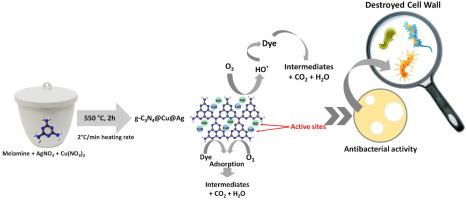Development of bimetallic g-C3N4 nanocatalysts for efficient organic dye catalytic ozonation and antibacterial activities
IF 4.7
3区 材料科学
Q2 MATERIALS SCIENCE, MULTIDISCIPLINARY
引用次数: 0
Abstract
The catalytic ozonation performance of g-C3N4@Cu@Ag and g-C3N4@Cu@Ni nanocatalysts was systematically evaluated for the degradation of methylene blue (MB) and methyl orange (MO). The catalysts were successfully synthesized through a simple one-step thermal calcination of melamine with the corresponding metal nitrates. Their morphology, crystallinity, and composition were characterized using X-ray powder diffraction (XRD), scanning electron microscopy (SEM), Fourier-transform infrared (FTIR), Raman spectroscopy, and Energy-dispersive X-ray (EDS), which confirmed the formation of porous nanosheets with uniform metal dispersion and well-integrated CuO, AgO, and NiO phases. The g-C3N4@Cu@Ag catalyst exhibited outstanding performance with 95 % MO removal (k = 0.045 min−1) under alkaline conditions, achieving 80.23 % mineralization efficiency after four reuse cycles, with minimal loss due to intermediate adsorption and partial metal leaching. In addition to dye degradation, g-C3N4@Cu@Ag demonstrated broad antimicrobial activity. It produced inhibition zones of 1.40 cm (Enterococcus), 1.25 cm (Bacillus cereus), 1.00 cm (K. pneumoniae and Pseudomonas), and significant antifungal action with 5.0 cm against Aspergillus niger and 4.2 cm against Candida albicans. In contrast, pristine g-C3N4 and g-C3N4@Cu@Ni showed negligible inhibition. These results highlight the intrinsic Cu–Ag–g-C3N4 synergy in enhancing ozone activation and hydroxyl radical generation, while conferring dual functionality, efficient catalytic ozonation and potent antimicrobial effects, making g-C3N4@Cu@Ag a promising multifunctional material for sustainable wastewater treatment.

双金属g-C3N4纳米催化剂的开发及其对有机染料的催化臭氧氧化和抗菌活性
系统评价了g-C3N4@Cu@Ag和g-C3N4@Cu@Ni纳米催化剂对亚甲基蓝(MB)和甲基橙(MO)的降解性能。催化剂是通过三聚氰胺与相应的金属硝酸盐的简单一步热煅烧成功合成的。利用x射线粉末衍射(XRD)、扫描电镜(SEM)、傅里叶变换红外(FTIR)、拉曼光谱(Raman)和能谱x射线(EDS)对其形貌、结晶度和组成进行了表征,证实了形成了金属分散均匀、CuO、AgO和NiO相集成良好的多孔纳米片。g-C3N4@Cu@Ag催化剂在碱性条件下的MO去除率达到95% (k = 0.045 min−1),重复使用4次后的矿化效率达到80.23%,中间吸附和部分金属浸出造成的损失最小。除了染料降解外,g-C3N4@Cu@Ag还表现出广泛的抗菌活性。对肠球菌(Enterococcus)、蜡样芽孢杆菌(Bacillus cereus)、肺炎克雷伯菌和假单胞菌(Pseudomonas)的抑制区分别为1.40 cm、1.25 cm和1.00 cm,对黑曲霉(Aspergillus niger)和白色念珠菌(Candida白色念珠菌)的抑制区分别为5.0 cm和4.2 cm。相反,原始g-C3N4和g-C3N4@Cu@Ni的抑制作用可以忽略不计。这些结果突出了Cu-Ag-g-C3N4在增强臭氧活化和羟基自由基生成方面的内在协同作用,同时赋予双重功能,高效的催化臭氧化和有效的抗菌作用,使g-C3N4@Cu@Ag成为一种有前途的多功能材料,用于可持续废水处理。
本文章由计算机程序翻译,如有差异,请以英文原文为准。
求助全文
约1分钟内获得全文
求助全文
来源期刊

Materials Chemistry and Physics
工程技术-材料科学:综合
CiteScore
8.70
自引率
4.30%
发文量
1515
审稿时长
69 days
期刊介绍:
Materials Chemistry and Physics is devoted to short communications, full-length research papers and feature articles on interrelationships among structure, properties, processing and performance of materials. The Editors welcome manuscripts on thin films, surface and interface science, materials degradation and reliability, metallurgy, semiconductors and optoelectronic materials, fine ceramics, magnetics, superconductors, specialty polymers, nano-materials and composite materials.
 求助内容:
求助内容: 应助结果提醒方式:
应助结果提醒方式:


